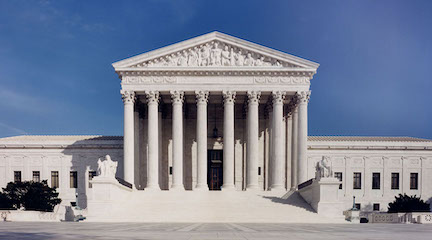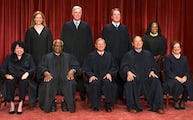 |
A Vacancy on the Court | < |
The President
Regarding the due administration of justice as the strongest cement of good government, I have considered the first organization of the Judicial Department as essential to the happiness of our Citizens, and to the stability of our political system. Under this impression it has been an invariable object of anxious solicitude with me to select the fittest Characters to expound the laws and dispense justice. - George Washington Presidential MotivationsMost presidents seem to follow the equivalent of a biological imperative when appointing justices to the Supreme Court. They want to appoint people who will decide cases in much the same manner and reflecting the same values that they themselves hold. Ideology drives the nomination process. This is more true for a president like Reagan, who had a strong commitment to ideology, than for one like Eisenhower or even Clinton, whose ideological predispositions were less strongly held. President Bush clearly demonstrated this imperative when he personally vouched for the value-set of Harriet Miers as being a like-minded nominee before being driven by his conservative political base to a more openly ideological choice of Samuel Alito. President Obama clearly sought out what he hoped would be like-minded justices in Sotomayor and Kagan, while simultaneously hoping to gain points among Hispanics and women for his choices. President Trump has heeded the considerable input of the Federalist Society in developing and even publicizing an extensive list of potential candidates, in part to get feedback on how the nomination of any one of them would play, not only with his political base but perhaps some additional identifiable groups. It is also true, however, that most presidents take their responsibility with the seriousness expressed by George Washington in the quote above. The result is usually a genuine effort at finding a highly qualified person within the constraints imposed by the nomination setting and the president's criteria. Nested within the ideological imperative are ulterior motives that can influence particular choices by a president. Among these motives are:
Framing the NominationOf course, to hear them tell it, presidents nominate only the best qualified people. Clinton characterized Breyer as "one of the outstanding jurists of our age," and Ginsburg was "one of our nation's best judges (with an) historic record of achievement." President Bush declared Thomas to be "the best qualified at this time." For President Nixon, Clement Haynsworth, who would ultimately be rejected, was an "eminently qualified jurist, scholar, and intellect." Even Nixon, though, sensed that the normal superlatives couldn't be stretched too far. His relatively lukewarm description of Harold Carswell as "fair and . . . a very competent judge" played into the hands of the opposition, who successfully challenged Carswell's qualifications to serve on the Court. One of the more successful efforts in framing nominations came with the use of the term "strict constructionist, " to describe a nominee. First used by Andrew Jackson, the term was revived by Richard Nixon as a cover term for his intention to appoint individuals to the Court who would bring a politically conservative voice to what he viewed as a very liberal Court. Don't be fooled either by the use of the term "judicial activist". Conservatives have done a good job at equating the term with justices seen as more liberal in their jurisprudence. In fact, however, there is no lack of judicial activism among the more conservative justices in behalf of their favored jurisprudential views. President Bush's PicksOnly in his second term was President Bush provided an opportunity to appoint a justice to the Supreme Court. It came at an opportune time.The Republicans had increased their Senate majority from 51 to 55 members in the 2004 elections and his support in the Senate was a healthy 74% in terms of winning votes on his positions regarding legislation. His approval rate among voters of 45% regarding his performance as president seemed low at the time, but it was destined to drop even more as the 2006 election loomed. The initial vacancy of Justice O'Connor, the quintessential pivotal justice in closely divided Court decisions, meant that both the left and the right pressured the president and the Senate to fill the vacancy with one they perceived to be friendly to their respective causes. My speculation that President Bush would seek a nominee who could only be described as right of center, possibly even far right of center, was borne out. With John Roberts, President Bush put forward a young (50) and well-respected attorney with two years experience on the D.C. Circuit Court who satisfied the president's conservative judicial sentinels but roused some opposition from liberal judicial watch groups. With the death of Chief Justice Rehnquist, the president deftly shifted the Roberts nomination to the Chief Justice position, easing the controversy somewhat because of replacing one conservative on the Court with another. The president then nominated Harriet Miers to replace O'Connor, choosing a woman to replace a woman and with one whose conservative credentials were less than impeccable. This strategy diminished opposition from the left, but in a scenario rarely seen in appointment politics, the president's own conservative political base denounced the nomination. Miers withdrew as a nominee and the president responded to the demands of the conservatives by nominating Samuel Alito. Alito withstood the opposition from the left, and the president succeeded in making the Supreme Court the most conservative of the modern (post-1954) era. President Obama's PicksFor the first two years of his term, President Obama had the power to appoint virtually any qualified individual to the Court, the Democrats holding a strong majority in the Senate. Prior to his making any appointments, I speculated that Obama would likely nominate an individual, not necessarily a sitting judge, with liberal sensibilities, but who could also attract some degree of bipartisan support, even though such support might not be needed to secure an appointment. I also thought he would find the presence of only one female justice and only one non-Anglo as insufficient. Of course, he would be expected to seek nominees who could have long and distinguished careers on the Court, likely between the ages of 45 to 55. His first appointee, Sotomayor, was a 55 year-old woman of Puerto Rican descent with 17 years experience as a judge, and his second appointment, Kagan, was a 50 year-old female with no prior judicial experience. Both clearly fit a more liberal jurisprudence, as least as we measure such things for justices. Given their credentials, however, and the fact that the justices they would replace were from the liberal bloc and the balance on the Court was not at stake, one might have expected both choices to have attracted bipartisan support, but Republicans proved to be rather ideologically sensitive. Sotomayor managed nine Republicans votes; Kagan received only five, while losing the support of one Democrat. Obama had no further opportunity to nominate a justice to the Court until the death of Justice Scalia in 2016. Despite a Repbulican-controlled Senate declaring in advance that no nominee from Obama would be considered, the president nominated Merrick Garland, a well-respected judge from the DC Circuit, who easily established the record for the length of time a nominee has waited from some action to be taken by the Senate. The Republican gamble that they would retain control of the Senate and that a Republican would be elected president had paid off. President Trump's PicksDonald Trump came into office with the Scalia vacancy just awaiting his inauguration and an angry group of Democrats over the Republican refusal to consider Obama's nomination. Republican control of the Senate, at 52-48, was insufficient to withstand any filibuster by the Democrats, so the Republicans wasted little time in implementing the so-called nuclear option to eliminate its application in the appointment of Supreme Court justices. Trump's initial list of 21 individuals contained 18 Anglos and 17 men, not out of line for a conservative president. In selecting Neil Gorsuch, he picked the person generally considered to be closest in interpretative style to Scalia. The retirement of Anthomy Kennedy provided Trump the opportunity to profoundly change the dynamic on the Court, securing the solid conservative majority the Republicans have long sought. Trump quickly developed a list of potential nominees. In choosing Brett Kavanaugh, the president selected a strong conservative with solid credentials, one who would normally be a shoo-in for confirmation. But Kavanaugh's high school and college days came back to haunt him with charges of sexual misconduct. Confirmed by a 50-48 vote, the Republicans prevailed.While President Carter had no Supreme Court vacancies to fill during his term of office, Ginsburg's death gifted Trump with his third nomination, the first president since Richard Nixon to have it so. Recognizing the need to replace Ginsburg with another woman, two stood out. Nominating Barbara Lagoa, a 52-year old daughter of Cuban refugees with extensive experience in the state courts and a member of the Federalist Society, would conceivably boost his standing in Florida, a pivotal state in the presidntial election. He chose instead to nominate Amy Coney Barrett, a 48-year old with her own compelling narrative, strong religious commitment, and outstanding credentials coming out of Notre Dame, who is expected to bring a Scalia-like jurisprudence to the Court. Her selection is expected to appeal more broadly to Trump's religious base. The resulting 6-3 conservative-liberal split on the Court seals the deal for the fifty-year quest by conservatives to have its people on the Court. President BidenPresident Biden has indicated that he will fill the next vacancy with a black woman. He has not named any names, but others have. Among them with their 2021 ages in parentheses are:
Last update: 1/26/2021 by George Watson .......................................................................................................... |